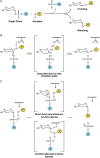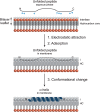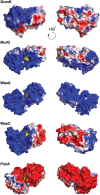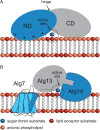Structure-function relationships of membrane-associated GT-B glycosyltransferases
- PMID: 24253765
- PMCID: PMC3907083
- DOI: 10.1093/glycob/cwt101
Structure-function relationships of membrane-associated GT-B glycosyltransferases
Abstract
Membrane-associated GT-B glycosyltransferases (GTs) comprise a large family of enzymes that catalyze the transfer of a sugar moiety from nucleotide-sugar donors to a wide range of membrane-associated acceptor substrates, mostly in the form of lipids and proteins. As a consequence, they generate a significant and diverse amount of glycoconjugates in biological membranes, which are particularly important in cell-cell, cell-matrix and host-pathogen recognition events. Membrane-associated GT-B enzymes display two "Rossmann-fold" domains separated by a deep cleft that includes the catalytic center. They associate permanently or temporarily to the phospholipid bilayer by a combination of hydrophobic and electrostatic interactions. They have the remarkable property to access both hydrophobic and hydrophilic substrates that reside within chemically distinct environments catalyzing their enzymatic transformations in an efficient manner. Here, we discuss the considerable progress that has been made in recent years in understanding the molecular mechanism that governs substrate and membrane recognition, and the impact of the conformational transitions undergone by these GTs during the catalytic cycle.
Keywords: X-ray crystallography; carbohydrate-modifying enzyme; glycosyltransferase; membrane protein; structural biology.
Figures










Similar articles
-
Quick-soaking of crystals reveals unprecedented insights into the catalytic mechanism of glycosyltransferases.Methods Enzymol. 2019;621:261-279. doi: 10.1016/bs.mie.2019.02.034. Epub 2019 Mar 23. Methods Enzymol. 2019. PMID: 31128783
-
Fold recognition analysis of glycosyltransferase families: further members of structural superfamilies.Glycobiology. 2003 Oct;13(10):707-12. doi: 10.1093/glycob/cwg098. Epub 2003 Jul 24. Glycobiology. 2003. PMID: 12881407
-
The conformational plasticity of glycosyltransferases.Curr Opin Struct Biol. 2016 Oct;40:23-32. doi: 10.1016/j.sbi.2016.07.007. Epub 2016 Jul 21. Curr Opin Struct Biol. 2016. PMID: 27450114 Review.
-
Deep evolutionary analysis reveals the design principles of fold A glycosyltransferases.Elife. 2020 Apr 1;9:e54532. doi: 10.7554/eLife.54532. Elife. 2020. PMID: 32234211 Free PMC article.
-
Polysaccharide-synthesizing glycosyltransferases and carbohydrate binding modules: the case of starch synthase III.Protein Pept Lett. 2013 Aug;20(8):856-63. doi: 10.2174/0929866511320080003. Protein Pept Lett. 2013. PMID: 23286550 Review.
Cited by
-
Structural insights into polyisoprenyl-binding glycosyltransferases.Structure. 2025 Apr 3;33(4):639-651. doi: 10.1016/j.str.2025.01.003. Epub 2025 Jan 29. Structure. 2025. PMID: 39884274 Review.
-
Protein Glycoengineering: An Approach for Improving Protein Properties.Front Chem. 2020 Jul 23;8:622. doi: 10.3389/fchem.2020.00622. eCollection 2020. Front Chem. 2020. PMID: 32793559 Free PMC article. Review.
-
Architecture, Function, Regulation, and Evolution of α-Glucans Metabolic Enzymes in Prokaryotes.Chem Rev. 2024 Apr 24;124(8):4863-4934. doi: 10.1021/acs.chemrev.3c00811. Epub 2024 Apr 12. Chem Rev. 2024. PMID: 38606812 Free PMC article. Review.
-
Mechanistic insights into the allosteric regulation of bacterial ADP-glucose pyrophosphorylases.J Biol Chem. 2017 Apr 14;292(15):6255-6268. doi: 10.1074/jbc.M116.773408. Epub 2017 Feb 21. J Biol Chem. 2017. PMID: 28223362 Free PMC article.
-
Membrane Interaction of the Glycosyltransferase WaaG.Biophys J. 2015 Aug 4;109(3):552-63. doi: 10.1016/j.bpj.2015.06.036. Biophys J. 2015. PMID: 26244737 Free PMC article.
References
-
- Abdian PL, Lellouch AC, Gautier C, Ielpi L, Geremia RA. Identification of essential amino acids in the bacterial alpha-mannosyltransferase AceA. J Biol Chem. 2000;275:40568–40575. doi:10.1074/jbc.M007496200. - DOI - PubMed
-
- Andersen OS, Koeppe RE., II Bilayer thickness and membrane protein function: An energetic perspective. Annu Rev Biophys Biomol Struct. 2007;36:107–130. doi:10.1146/annurev.biophys.36.040306.132643. - DOI - PubMed
-
- Andersson AS, Rilfors L, Bergqvist M, Persson S, Lindblom G. New aspects on membrane lipid regulation in Acholeplasma laidlawii A and phase equilibria of monoacyl-diglucosyldiacylglycerol. Biochemistry. 1996;35:11119–11130. doi:10.1021/bi960561w. - DOI - PubMed
-
- Andrés E, Biarnés X, Faijes M, Planas A. Bacterial glycoglycerolipid synthases: Processive and non-processive glycosyltransferases in mycoplasma. Biocatal Biotransfor. 2012;30:274–287. doi:10.3109/10242422.2012.674733. - DOI
-
- Ardévol A, Rovira C. The molecular mechanism of enzymatic glycosyl transfer with retention of configuration: Evidence for a short-lived oxocarbenium-like species. Angew Chem Int Ed Engl. 2011;50:10897–10901. doi:10.1002/anie.201104623. - DOI - PubMed
Publication types
MeSH terms
Substances
Grants and funding
LinkOut - more resources
Full Text Sources
Other Literature Sources
Molecular Biology Databases
Research Materials
Miscellaneous

